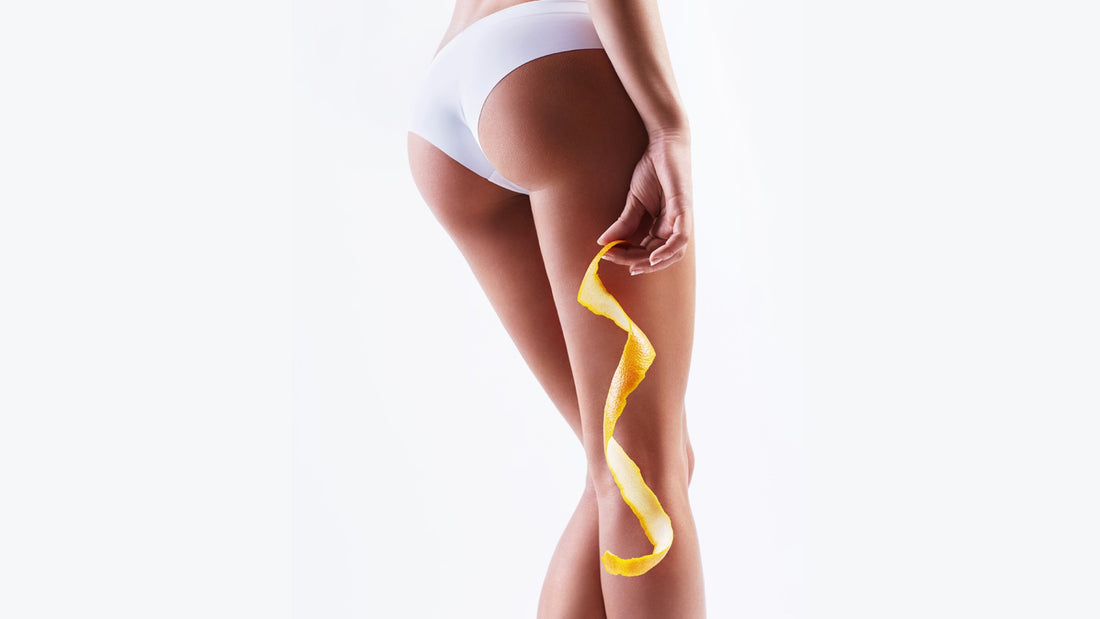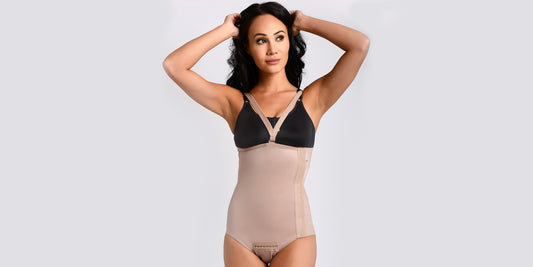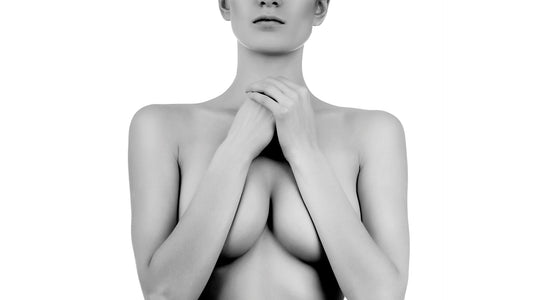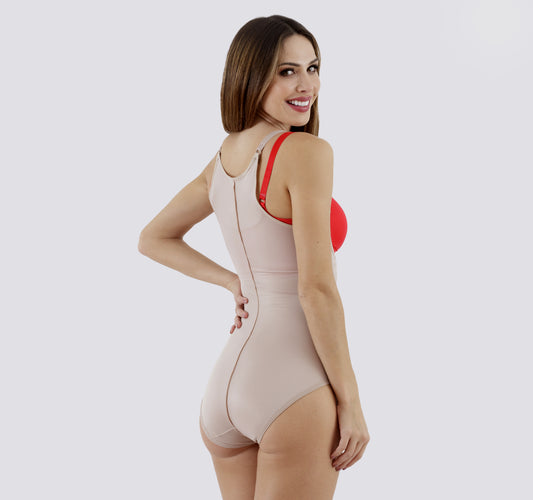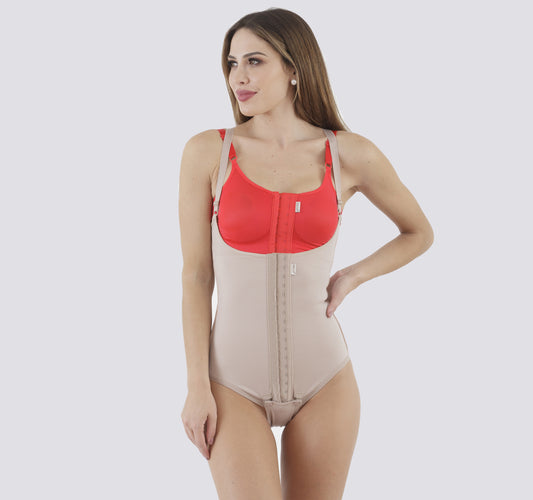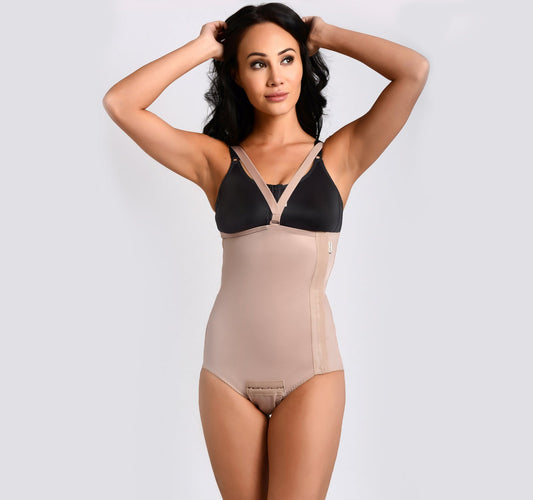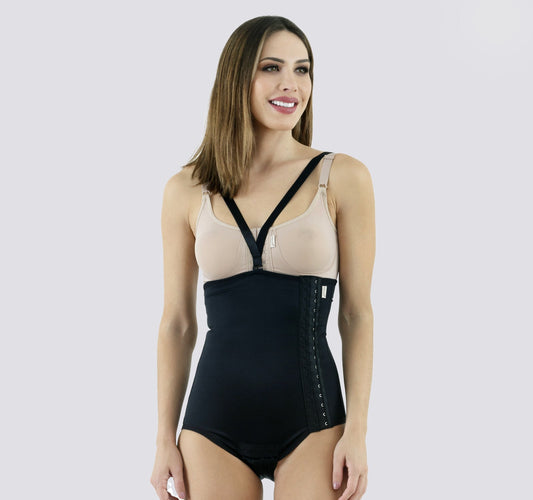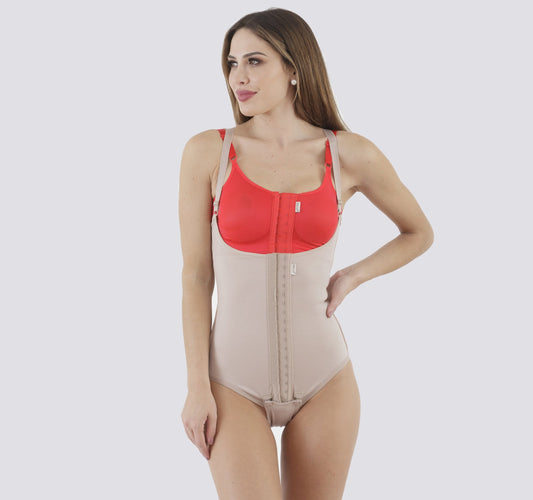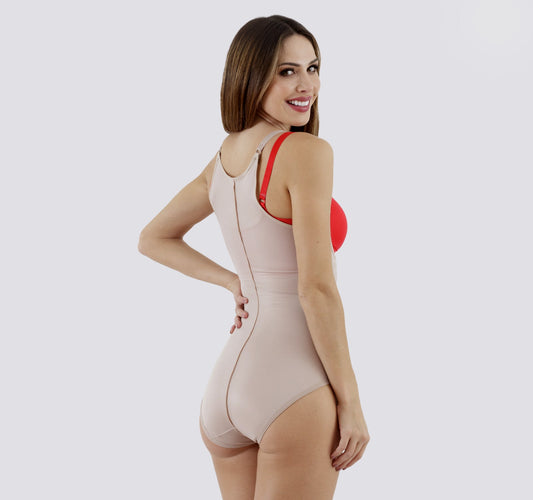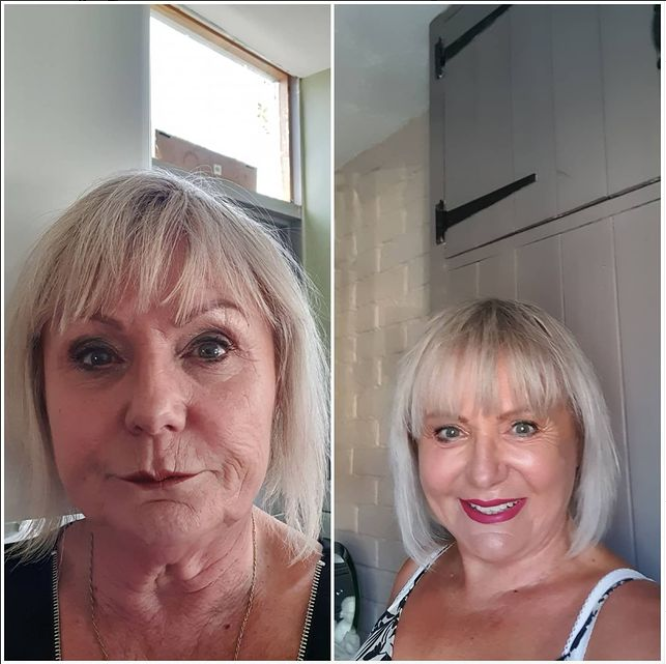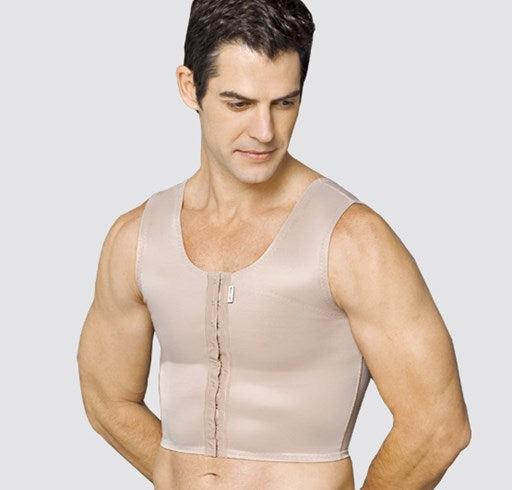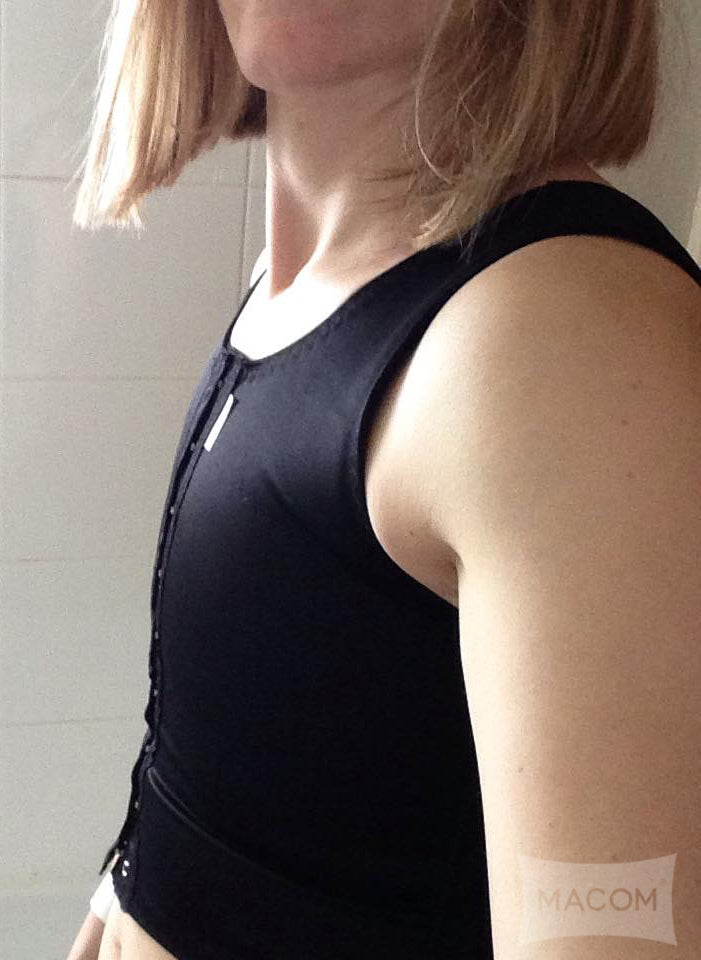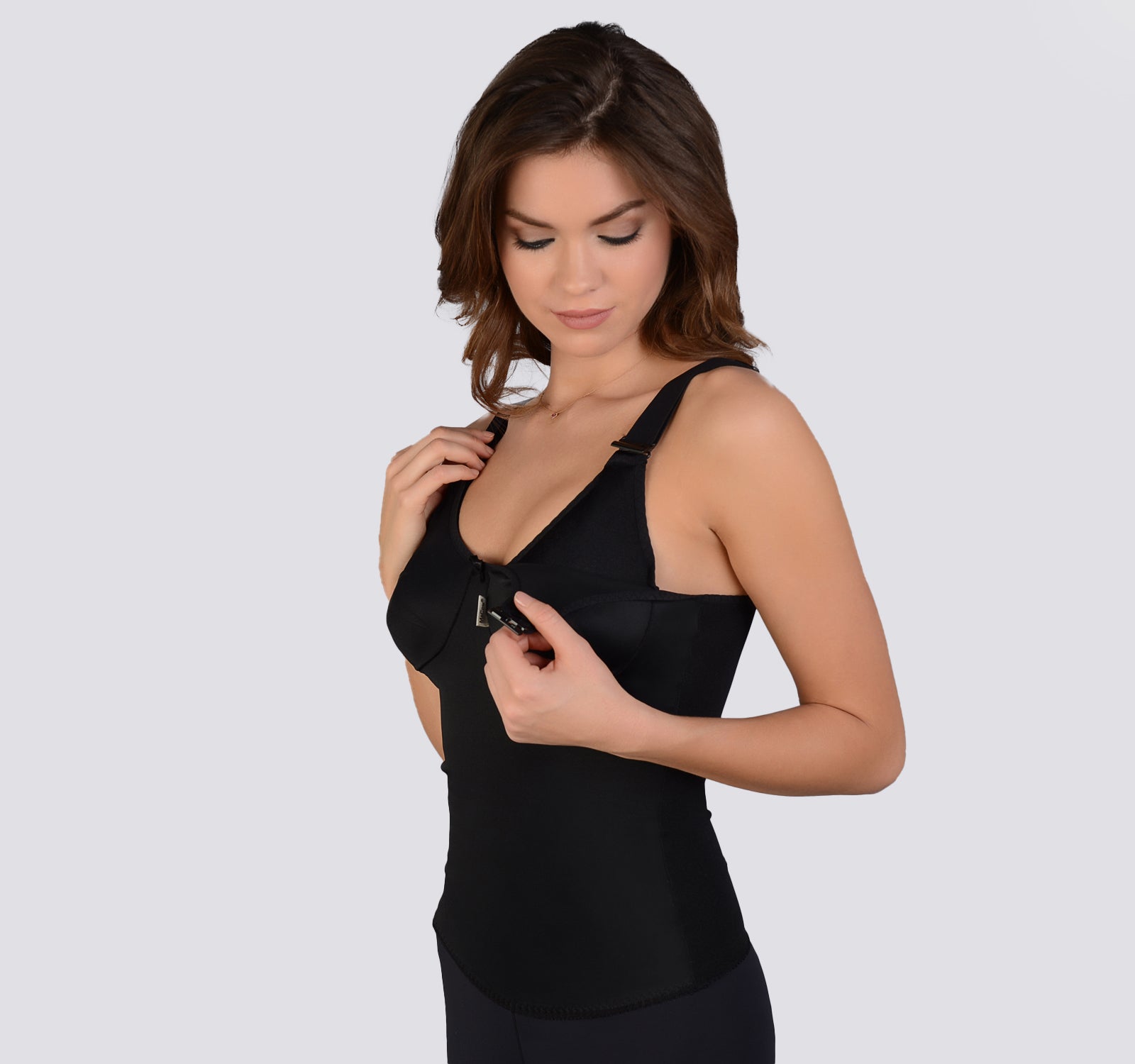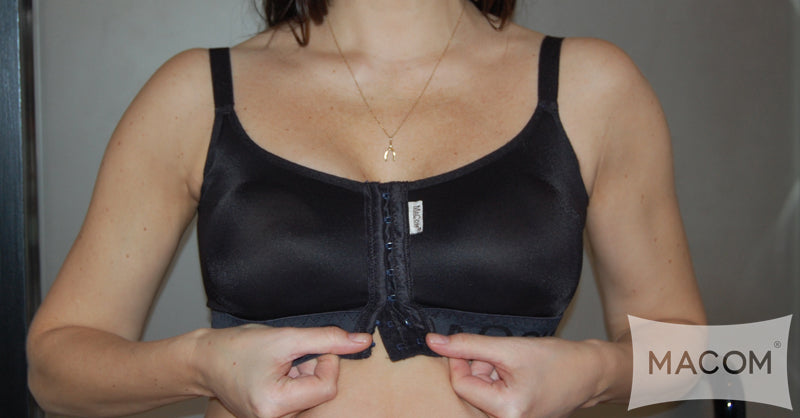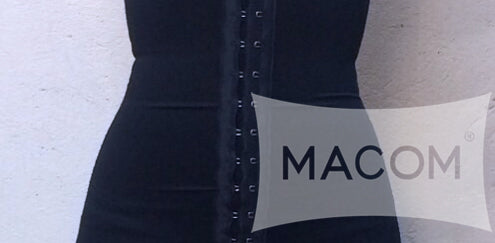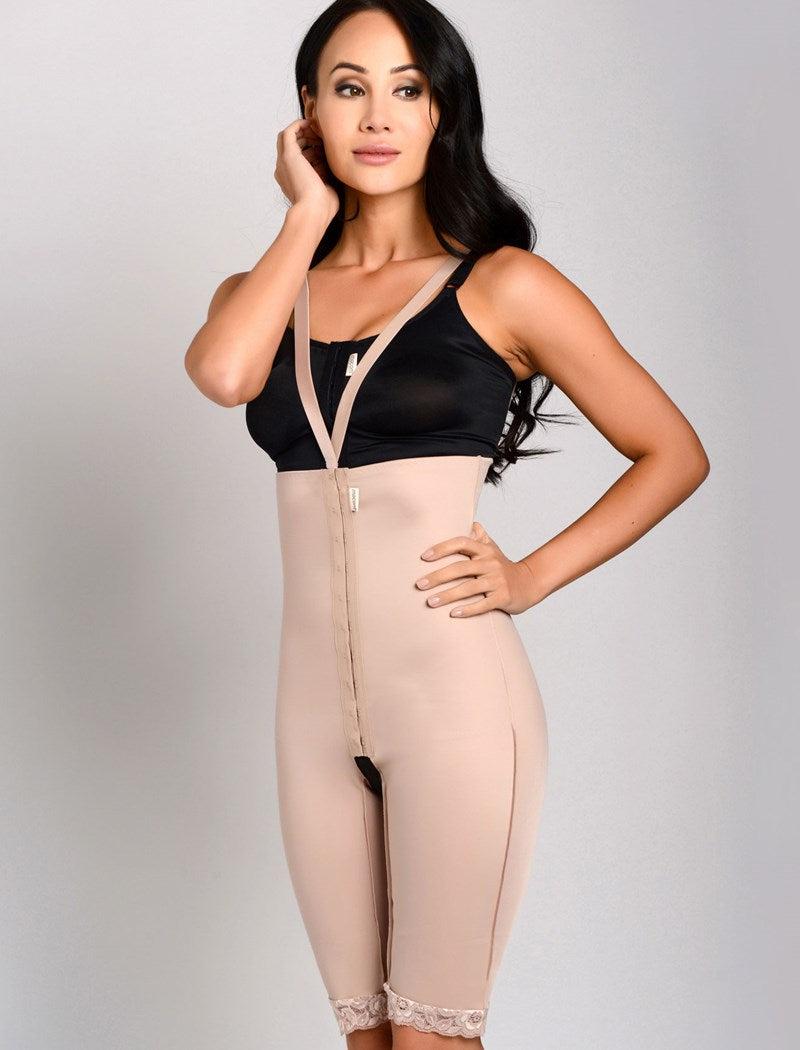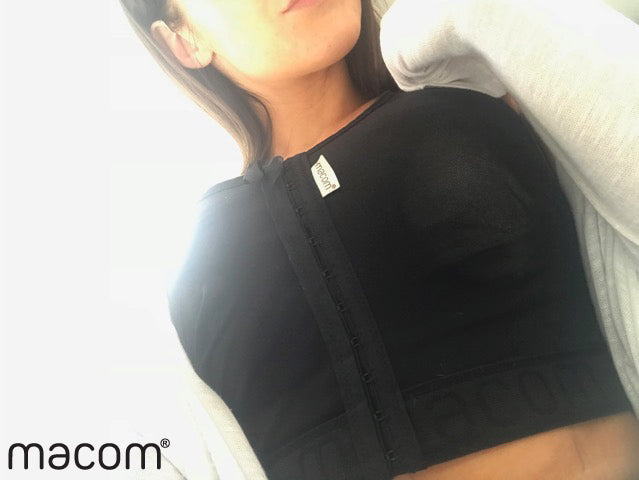Our comprehensive and accessible Ultimate Guide to Cellulite is here. With advice from experts, the macom® team explains what cellulite is, including causes and prevention techniques, and busts some of the myths about how cellulite appears and on whom.
What is cellulite?
Cellulite is a common and harmless skin condition that causes dimpled or lumpy textured skin. It typically appears on hips, thighs, buttocks and the abdomen. It predominantly, but not exclusively, affects women.
With cellulite, the lumps are caused by the collagen strands tightening, pulling the skin down, and the bumps or nodules are the result of fat cells pushing against the skin. It is worth noting that cellulite isn’t just excess fat, which is why very thin or toned women still see cellulite lumps and bumps. Rather, cellulite is the result of fat cells pushing up against the skin, constricted by tight, short, fibrous bands in the dermis.
One medical name for cellulite is ‘Oedematous FibroSclerotic Superficial Panniculitis’. In laymans’ terms, it means: inflammation of the fat cells in the adipose or superficial layer of the dermis combined with scar tissue or hardening of the connective tissues, plus water retention.
Virtually all of us have cellulite and many dislike it and so spend time and money trying to eradicate it. So what ways are there to deal with cellulite? And are they medical or cosmetic solutions?
Cellulite is a cosmetic skin condition, not a medical one
Cellulite is not a medical condition and is deemed purely cosmetic by the medical community. However, that doesn't mean it isn't an issue that causes a lot of distress to those who have it, or that it isn’t uncomfortable or even painful for some people – pain typically occurs in the cellulite on the legs when someone has been seated for a long time.
Though a cosmetic skin condition, some of the cellulite-busting treatments available are best performed by a properly qualified and experienced medical professional. We cover this in more depth below in the treatments for cellulite section.

Types of cellulite
Cellulite isn’t just a single problem and knowing about the different types of cellulite is essential to find the most effective treatment. Here are the three different types of cellulite:
1. Soft cellulite
Also known as flaccid cellulite, soft cellulite is associated with sagging skin and is often found on body areas where fat accumulates, such as the arms, stomach, hips, buttocks and legs. It is more visible when you are lying down rather than standing.
The good news is that soft cellulite isn’t painful when touched, although the skin can feel very gelatinous and undulating. Weight gain or lack of tone is typically the cause of this type of cellulite.
The best advice for tackling soft cellulite is often to adopt a rigorous diet and exercise routine as this can help visibly improve the appearance of soft cellulite. Wearing CRYSTALSMOOTH® leggings while you exercise can also boost your results.
2. Hard cellulite
Hard or compact cellulite is the cause of what is colloquially known as ‘orange peel’. This type of cellulite can affect all people, including slim and toned people. It is characterised by depressions and blemishes on the thighs, glutes and hips. Severe cases can feel very hard and painful to the touch.
Treating hard cellulite is difficult and preventing it is not possible if you’re susceptible to developing this type of cellulite. Some cosmetic surgeons recommend excision-based treatments, such as Cellfina, for those who want to try and get rid of compact cellulite. These are relatively new, minimally invasive, procedures that use a microblade technique to release the hardened fibrous tissues, producing long-term results.
3. Edematous cellulite
Also known as poor circulation cellulite, edematous cellulite is the least common form of cellulite and can be very challenging to treat. It results from poor blood circulation which is aggravated by fluid retention.
Edematous cellulite can affect the thighs and knees, but most frequently presents in the lower legs, altering the shape of the legs as they swell. The skin may feel painful when touched or if you’ve been sitting for a long period of time.
Treatment for edematous cellulite focuses on improving blood circulation and reducing fluid retention, such as with compression socks and hot baths. For very severe edematous cellulite, lymphatic drainage, a manual massage technique, can be beneficial.
Grades of cellulite
In 2009, a scale was developed for cellulite that graded it into four different categories from mild to severe. This is how those cellulite grades are broken down:
Grade 0
Cellulite isn't apparent to the naked eye and the skin still appears smooth even when pinched, but there may be changes to the structure of the dermis taking place beneath the skin.
Grade 1
There might not be visible bumps and dimples, but the skin appears paler with decreased elasticity and when the skin is pinched, an orange peel effect appears.
Grade 2
Lumps and bumps start to become visible, particularly when you stand, but disappear when you lie down.
Grade 3
This is the most severe grade of cellulite. Dimples are now visible at all times. Often the area can become hard and painful.
What causes cellulite?
Increasing fat cells push up against the skin while connective cords pull down, resulting in cellulite lumps and bumps. What causes this and makes a person more susceptible to developing cellulite varies. Causes of cellulite can include: hormones, aging, genetics, diet, smoking and inactivity.
Cellulite is very rarely caused by a single factor but is often the result of a number of issues. Below, we look at each of the common causes of cellulite in more detail.
Hormones
Hormones play an important role in the development of cellulite. Oestrogen, the three thyroid hormones, insulin, noradrenaline and prolactin, are all part of the process by which cellulite is produced.
Just as there are a variety of types of cellulite, it can be brought on by hormonal changes at different times of life. For example, as oestrogen levels rise in women during puberty, this can trigger the development of cellulite. Similarly, pregnancy-related hormonal fluctuations can also make cellulite develop. When women enter the menopause, their levels of oestrogen decrease, causing blood flow to the connective tissues under the skin to fall. This decrease in blood flow means less oxygen getting to the area and therefore lower collagen production, which can lead to edematous cellulite. Fat cells also tend to enlarge as oestrogen levels drop – the reason why we suffer from the menopausal middle-aged spread – leading to more significant and more visible cellulite in older age.
Some specialised clinics offer a hormonal approach to reducing cellulite. This can be costly and take longer to see results, but is considered an effective way to tackle a whole host of ageing concerns alongside cellulite.
Age
Alongside the menopause causing hormonal havoc, as women get older their skin becomes thinner, less elastic and more prone to sagging. Furthermore, muscle mass reduces as you get older – physically inactive women can lose as much as 3% to 5% of muscle mass and function each decade after the age of 30. As a result, fat in the body, and so cellulite, will often start to appear to be developing faster as it becomes more visible.
Treatments that use radiofrequency (RF) therapy or high intensity focused ultrasound can firm and tone sagging skin and so reduce the appearance of cellulite. The downside is that these procedures can be time consuming and costly. Remaining physically active, whether through cardio or weight training, is important as you get older. Alongside the many health benefits, it can help keep ageing concerns such as cellulite at bay.
Genetic factors
Certain genes are linked to how fast your metabolism works, how fat is distributed and the efficiency of your circulation or lymphatic drainage system. Cellulite also seems to be more prominent in some ethnic groups. While cellulite can affect women from all ethnicities, it is more prevalent in white, European ethnic groups.
Scientists have also identified two specific genetic variations that were found in subjects suffering from cellulite: ACE and HIF1A. Further research has worked out which gene variant is responsible for either moderate or severe cellulite. A good indication, however, is that if your mother and grandmother had cellulite, then you have a higher chance of also developing it.
There isn't anything you can do about your genetic inheritance. However, it’s important to remember that a lack of cellulite in your family doesn't stop you from getting cellulite, as there are multiple types and multiple factors.
Diet
Diet can be a factor in the development of cellulite in your body. Cellulite is not caused by toxins, but an unhealthy lifestyle is considered a contributing factor in worsening cellulite. There is also no magical list of foods you can avoid; instead look for foods that are known to cause inflammation as that results in your fat cells becoming enlarged and holding onto fluids and toxins. These toxins slow down lymphatic drainage and contribute to the breakdown of collagen and elastin in our skin.
Refined carbs, for example, are one of the main inflammation- causing food groups. The grain is missing one of the key components that make it a whole grain, stripping it of essential proteins, fibre, minerals and vitamins. Refined carbs are found in white bread, rice and flour or as refined sugars in cake, cereals and sugary drinks. Too much refined and processed foods, unhealthy fat, carbs, salt and too little fibre can all encourage cellulite to form.
To try and stave off cellulite, you should look to ensure you get enough amino acids and proteins in your regular diet, as these are key to healthy collagen production and connective tissue. Lymphatic drainage can help with blocked lymph cells and improve drainage of toxins from the body.
Smoking
Smoking itself won’t directly cause cellulite, but the negative impact it has on your skin health can ensure that cellulite will become more visible or worsen as you age. This is because nicotine in cigarettes is a vasoconstrictor. Vasoconstriction is when the blood vessels become constricted, lessening oxygen being delivered into the dermis. This, in turn, impacts on the formation of collagen. Lack of oxygen also affects your circulatory and drainage systems and ages your skin.
Cigarette smoke also contains thousands of different chemicals, such as acetylene, ammonia, benzene, formaldehyde and methanol, and all these toxins produce free radicals that damage the connective tissue of the skin, making cellulite look even worse.
The simplest solution is to stop smoking. This includes vaping, which is only slightly better than smoking because although it doesn’t contain tar it still delivers nicotine into the bloodstream.
Inactivity
A sedentary lifestyle may contribute to the appearance of cellulite, but this isn’t a definitive cause. As mentioned above, even very fit and active people can suffer from cellulite. However, exercising a few times a week often isn’t enough to combat the effect of working in a sedentary occupation, whether sitting or standing for long periods of time.
Inactivity causes a calorie imbalance that encourages the storing of fat cells in the cellulite layer. Lack of mechanical stimulation also causes collagen and elastin production to slow down, making your skin less taut and firm.
Click here to find out more about Exercise + Cellulite.
Although exercise is an important tool for dealing with cellulite, it’s thought that lactic acid build-up, which is very common after exercise, can make cellulite worse in those who have a predisposition to it. Doing your leg exercises on a vibrating plate increases circulation in your lower body, meaning quicker removal of waste products such as lactic acid.
Who can get cellulite?
Cellulite is most common in those who have excess fat, and is more likely after age 25. It affects 90% of women and 10% of men.
Why do so many women get cellulite?
It’s estimated that 90% of all women have cellulite to some degree and, furthermore, caucasian women are most prone to this problem. There are a number of reasons for this, including hormones, fat distribution and skin structure.
Skin structure
It’s thought that women have a distinctive structure to their dermis that makes them more prone to developing cellulite. The connective tissues that keep a smooth appearance to the overlying skin in the thighs are thinner in women and when the fat bulges against the surface of the skin, lumps and bumps are formed.
Fat distribution
Evolution has given women softer, rounder hips and thighs to attract males, but unfortunately it also means we are more prone to put on fat in these areas and our modern diets and sedentary lifestyles result in excess fat putting pressure on the connective tissue in our dermis.
Hormonal changes
The important hormonal stages in a woman’s life – puberty, pregnancy and the menopause – are all linked to the appearance or worsening of cellulite.
Why do some women appear immune to cellulite?
Everyone’s body is unique and some women may have won the genetic lottery, whether that’s in terms of fat composition, skin thickness, collagen structure or different hormone levels.
Also, those women who you envy for their toned and taut thighs? They probably do have some degree of cellulite – grade one cellulite often isn’t visible – which may become more noticeable as they get older.
One life event that affects all women, even those who have remained dimple-free throughout, is the menopause where the steep drop in oestrogen levels significantly increases your potential to develop cellulite.
Can men get cellulite?
Cellulite is so prevalent in the female population that it is sometimes described as a secondary sex characteristic i.e. a condition only pertaining to women. But, are all men immune to cellulite?
Cellulite occurs when you have an excessive calorie intake to activity output and high levels of oestrogen. The latter is key for why women are more likely to suffer from cellulite – men do have oestrogen in their body but at much lower levels. Instead, they have much higher levels of testosterone, which effectively protects them from the formation of cellulite.
Men and women also tend to put weight on differently. Whereas women often accumulate fat in the lower body, where cellulite is most likely to develop due to the infrastructure of the dermis, male fat accumulation is typically in their middle. The fat cells in the hips and thighs are the most sensitive to oestrogen.
Although most men are safe from cellulite, it doesn’t mean they are completely immune. As men get older, hormonal imbalances mean an increase in oestrogen. Combine this with putting on weight and lack of exercise, and men can develop cellulite too.
A love of beer can also be problematic as it contains hops which contain high levels of a very potent form of oestrogen and it’s been proven to lower testosterone levels.
Teens and cellulite
Although most women start to see cellulite appearing in their 20s and 30s, a typical teenage diet, full of junk food and sugar, combined with a technology-obsessed sedentary lifestyle and the intense hormone fluctuations of puberty, means more and more teenage girls are starting to suffer from the complaint.
It’s never too early to adopt a healthy lifestyle, which is the best way to avoid the problem getting worse. And don’t be fooled by all the social media images of perfect bodies – they are probably just filtering away any body imperfections such as stretch marks or cellulite.
Treatments for cellulite
Medical Aesthetician, Sandra Rimsaite, offers insights into the various types of cellulite treatment, including her opinion about how valuable they are to those seeking treatment for cellulite.
Pressotherapy
Pressotherapy is a controlled compression system that boosts the body’s natural detoxification process. The patient wears a tight body costume and the machine increases the pressure up the body, varying suction and pressure levels to produce a sensation similar to a manual massage.
As Sandra explains, “this is particularly suitable for women suffering from cellulite as a result of excess water retention or poor lymphatic drainage, but if there is a large degree of tissue hardening or lack of skin firmness, then I would recommend other treatments.”
Acoustic Wave Therapy
Using ultrasound gel, shock waves are directed into the legs to break down fatty deposits and improve microcirculation and lymphatic drainage. Sandra sees this procedure as an important part of the treatment process: “I would recommend it for all four grades of cellulite. I particularly like it because it can be used on the arms, bra fat and localised areas around the hips and thighs.”
Mesotherapy
Much beloved by French women where it was first invented, Mesotherapy is an effective cellulite treatment as it aids fluid retention, lymphatic drainage, localised fat reduction and skin rejuvenation.
“This is a fantastic, minimally invasive way to improve skin texture,” comments Sandra.
“We combine different cocktails of vitamins, minerals and antioxidants, blended with hyaluronic acid, depending on the patient’s needs and these are then injected into the skin to improve skin texture.”
Radiofrequency
Radiofrequency is a very effective, minimally-invasive approach to skin tightening and cellulite reduction. Radiofrequency energy is delivered into the dermis, heating tissues and stimulating collagen production.
There are a number of radiofrequency devices available, but one of Sandra’s preferred treatments is VelaShape (also known as VelaSmooth). “I typically include VelaShape into any cellulite treatment programme as it incorporates a number of cellulite- fighting actions in one procedure. The device utilises radiofrequency to tighten the tissue and infrared light to boost blood circulation and nutrient flow and then this is combined with manual stimulation with rollers and suction to improve skin texture.
“BTL EXILIS 360® can also be effective. This combines ultrasound with radiofrequency to stimulate collagen production, improve skin elasticity and reduce fatty deposits, alongside boosting microcirculation and lymphatic drainage.”
Other radiofrequency devices that treat cellulite include EndyMed 3DEEP, which uses radiofrequency technology to tighten and firm the skin and stimulate the body’s collagen renewal process. VenusFreeze combines multi-polar radiofrequency and pulsed electromagnetic fields to produce three times more radiofrequency energy.
Fat Dissolving Injections
Aqualyx is a gel-based aqueous solution which can be injected into localised, superficial fat pockets underneath the skin, dissolving the fat cells before the body naturally expels the released fatty acids. This can greatly improve the appearance of cellulite.
Cryolipolysis
Fat freezing has become the big buzzword in fat reduction and body contouring, but it can also improve the appearance of cellulite as it targets the superficial layer of fat. Fat cells are carefully frozen with no damage to the surrounding tissue and then naturally expelled from the body. Typically, one session is enough and you’ll start to see results over the following four weeks.
CoolSculpting is the market leader for fat freezing, but another device that incorporates cryolipolysis is the 3D-lipo system, along with ultrasound, radiofrequency, vacuum suction and rollers to reduce cellulite and improve body contours.
Laser
Cellulaze is a minimally invasive laser treatment that typically requires just one treatment and produces a long-lasting, visible improvement in cellulite. A small cannula is inserted into the dermis and then laser energy is delivered directly under the skin, releasing the fibrous bands that pull down the surface of the skin, while at the same time liquefying superficial fat and stimulating collagen production for a much smoother appearance.
Subcision
Cellfina is one of the newest cellulite treatment options and is a subcision or incision-based approach. The constrictive fibrous bands are released to improve the appearance of the lumps and bumps that are caused by cellulite. This technique does not require a general anaesthetic and is a highly effective, long-term treatment of deep dimples.
DIY
If you’re committed to getting the best results possible, there’s also a number of steps that you can take alongside your clinic treatments. Sandra’s recommendations include “wearing CRYSTALSMOOTH® leggings for a minimum six hours a day, even when you exercise or sleep. Contrast showers – where you use very hot water and then switch to cold water for the final few minutes – can also help to stimulate circulation and drainage in the legs. Body brushing might be seen as an old-fashioned cellulite method but it’s always in fashion as far as I’m concerned.”
Ageing is one of the physical factors in the development of cellulite, so Sandra believes that collagen-containing supplements such as Totally Derma can help to improve skin conditions on the bottom or thighs, as well as reversing signs of facial ageing. “I will often advise combining with botanical supplements such as Ginkgo biloba that help to improve circulation naturally.”
Improving skin texture from the outside is also important. “Topical retinol products that contain antioxidants such as vitamin A should be part of your daily skincare routine, but did you know they can also be applied to areas troubled by cellulite to improve skin condition? If you don’t want to use your expensive creams or serums, then look for products like La Roche- Posay that contains 0.3% strength retinol.”
“Cellulite isn’t an easy condition to treat and it’s not possible to eradicate it completely. However, with the right treatments and approach then I believe we can produce a marked improvement in the appearance of cellulite.”
How is cellulite assessed and treated by cosmetic surgeons?
Mr Ayham Al-Ayoubi, a Facial Plastic and Laser Surgeon, is the founder and Medical Director of The London Medical and Aesthetic Clinic at 1 Harley Street, London. Here, he shares his experience. Mr Al-Ayoubi says:
Cellulite is the eternal problem and I’ve been treating women for cellulite for the last 28 years since I became a laser and plastic surgeon. It is a common issue that can cause a great deal of distress and I see two to three patients a day seeking treatment, ranging from 20 to 65 years old.
As we know, it’s a common problem for women and this is due to basic differences between male and female anatomy. There are two types of fat. First, there is the superficial fat layer directly underneath the surface of the skin. The fat cells in this layer are very small and compacted, with collagen tissue running between the fat cells. This collagen tissue responds to certain factors, such as hormonal fluctuations in the body, and the skin becomes pulled down by collagen fibres, causing the pockets of fat cells to push against the skin.
Underneath the superficial layer of fat, is the loose or deep fat layer. Men typically have far more deep, loose fat so are less likely to develop cellulite. Women, unfortunately, have far more superficial fat, so are more prone to suffering from stretch marks and cellulite.
Now, understanding that cellulite is a fat-related condition rather than a problem relating to the skin is the first step. It means that any procedure or topical products that claim to treat cellulite by smoothing the overlying skin, will just not work.
Cellulite has traditionally been treated using laser or radiofrequency based devices. Although they can greatly improve the condition of your skin, they can’t target the superficial layer of fat without causing burning of the skin and damage to nerve endings. This explains the limited results that can be achieved with these types of devices.
Recently, though, there has been a breakthrough in the treatment of cellulite. Cellulaze is a laser surgical treatment that fractures the fibrous bands that pull down the surface of the skin. It’s minimally invasive but it is a surgical procedure.
Why use CRYSTALSMOOTH® leggings for treating cellulite?
Facial Plastic and Laser Surgeon, Mr Ayham Al-Ayoubi advises that:
I’ve been using these garments since they were first introduced because I believe they have many benefits. Their design is unique in that they are very thin, comfortable garments that can easily be worn under normal clothes unlike some of the other post-surgical products that are available. They also never irritate the skin. The underlying science is also unique to these products and sets them apart from the competition.
They can enhance the results of any surgical procedure for cellulite or fat reduction and I give every patient who undergoes the Cellulaze procedure the garment to wear during the healing process as it speeds up drainage. Patients find them extremely comfortable to wear and, as well as a significantly speedier recovery, they see a quicker improvement in the appearance of their skin than if they didn’t wear the garment.
I also advise patients that have undergone traditional liposuction or VASER lipo, to wear the macom garment because it applies gentle pressure that reduces the risk of complications such as haematoma or seroma.
Some patients might not be suitable for laser surgery, whether due to a medical issue or skin condition. In this case, we may perform an alternative procedure such as VelaShape or fat freezing. These treatments are usually performed over a number of sessions with intervals in-between. Again, I ask patients to wear the Macom garment to enhance their results.
The final group of patients that can benefit from the CRYSTALSMOOTH® leggings are those that don’t require any other procedure at this point; for example, a patient in their mid-20s who has grade one cellulite.
I recommend CRYSTALSMOOTH® leggings as a standalone treatment for patients that have grade one or very mild grade two cellulite because it introduces gentle heat into the skin, safely penetrating the superficial fat layer beneath.
So instead of suggesting an intensive course of VelaShape that requires them attending our clinic every week, these patients will see really good, visible results in a month or so of wearing the CRYSTALSMOOTH® leggings under their normal clothes.
I am very selective on who I operate or which procedures I offer. As with everything in life, success is measured by results and I never suggest unnecessary treatments just for the sake of it.
Common myths about cellulite: Fact vs fiction
Finally, we want to tackle some of the myths that surround cellulite. Despite the fact that most women suffer from cellulite, there are as many myths as truths about it. Here we take a look at the most common assumptions about cellulite and explain why they are fact or fiction.
1. Cellulite is caused by toxins – MYTH
One of the oldest old wives’ tales about cellulite is that it is caused by toxins – as evidenced by the amount of ‘toxin-eliminating’ creams and lotions on the market. Cellulite is the result of fat deposits constricted by collagen fibres, bulging against the overlying skin and, physiologically, the unique characteristic of someone’s skin structure indicates whether they are susceptible to developing cellulite.
However, although cellulite is not caused by toxins, they can make existing cellulite appear worse.
2. You can blame your genetics for cellulite – FACT
It is true that cellulite has a genetic element – or rather the predisposition to develop cellulite as other factors then also come into play – and if your mum or grandmother has cellulite then you are much more likely to suffer from it. Certain genes affect your metabolism, distribution of fat and efficiency of your circulatory and lymphatic drainage systems. In fact, a 2010 scientific study found that there are different gene variations that could determine whether you are more susceptible to moderate or more severe cellulite.
3. Liposuction can get rid of cellulite – MYTH
As cellulite is a fat problem, it seems to make sense that a fat reduction procedure, such as liposuction, could eliminate cellulite. Your medical practitioner inserts a cannula through a small incision and then removes fat cells permanently to improve body shape and eradicate pockets of stubborn fat. However, the one thing it doesn’t do is reduce cellulite and, in fact, it can sometimes make it look worse, depending on the patient’s skin quality.
Liposuction removes fat deposits from a deeper layer of the dermis to where cellulite is present. Furthermore, liposuction can result in excess skin and contour irregularities which can occasionally worsen the appearance of existing cellulite. Wearing a good-quality compression garment after liposuction is a must to avoid this problem.
4. There isn’t a permanent solution to cellulite (at the moment) – FACT
Although there isn’t currently a permanent and fool-proof way to eradicate cellulite totally, we do seem to be moving closer to finding a long-term and effective way to reduce the appearance of cellulite. Treatments that work by releasing the tight fibrous bands that constrict cellulite, such as Cellulaze and Cellfina, are an exciting development in treating cellulite. Cellfina currently has FDA approval for two years – although it is thought that results will last far longer, its relative newness means it can only promise this much at the moment.
Turn to our section on Cellulite + Exercise to find out more about our Cellulite Busting Exercise Routine.
Until a permanent solution is found, though, a treatment like CRYSTALSMOOTH® improves the appearance of cellulite and smooths skin, particularly when combined with exercise.
5. You can run off your cellulite – MYTH
While running is an excellent form of cardiovascular exercise, it’s not necessarily the best exercise to improve cellulite. Jogging doesn’t sculpt and build muscles nor work the key ones, namely your glutes and hamstrings, as well as other forms of exercise. Turn to our section on Cellulite + Exercise to find out more about our Cellulite Busting Exercise Routine.
6. Dermal fillers can ‘fill’ up your cellulite, smoothing away lumps and bumps – MYTH
Theoretically, this should make sense. Dermal fillers are a fantastic product for filling and restoring volume where it’s been lost, so surely you can just fill cellulite lumps to create a smooth surface to the skin.
The truth is, though, that dermal fillers are not suitable for treating cellulite and could make it appear worse. Cellulite indentations are caused by bands of constrictive tissue and you can’t simply push that area up by inserting filler into the area. Fillers could also spread, pushing up around the indentation, making it look even more noticeable. Furthermore, cellulite usually covers a large area of the body so the cost of using dermal fillers would be prohibitive.

